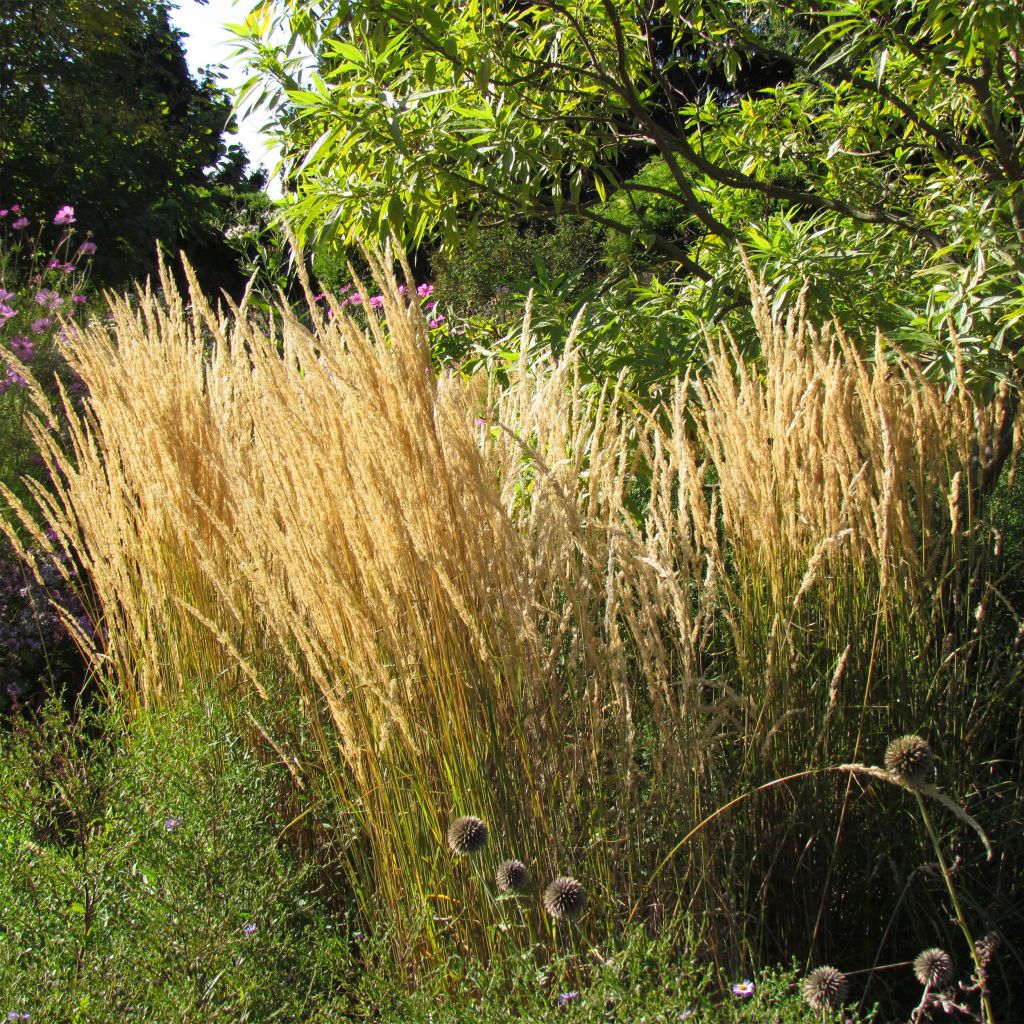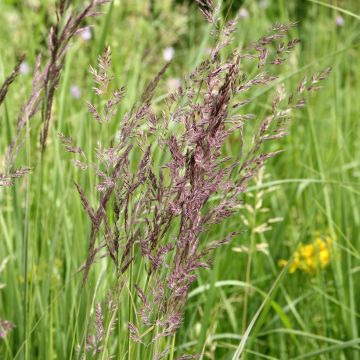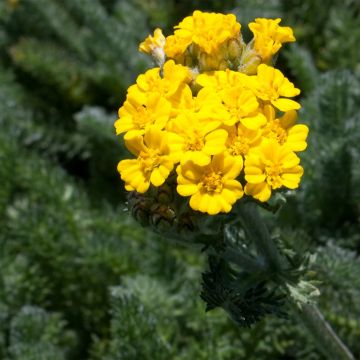

Calamagrostis acutiflora Karl Foerster - Feather Reed Grass


Calamagrostis acutiflora Karl Foerster - Feather Reed Grass


Calamagrostis acutiflora Karl Foerster - Feather Reed Grass
Calamagrostis acutiflora Karl Foerster - Feather Reed Grass
Calamagrostis x acutiflora Karl Foerster
Feather Reed Grass
Plants were good, lovely shoots from the 1st year.
Nicolas, 14/09/2024
This item cannot be shipped to the selected country
Delivery charge from €5.90
Delivery charge from €5.90
More information
Schedule delivery date,
and select date in basket
This plant carries a 12 months recovery warranty
More information
We guarantee the quality of our plants for a full growing cycle, and will replace at our expense any plant that fails to recover under normal climatic and planting conditions.
From €5.90 for pickup delivery and €6.90 for home delivery
Express home delivery from €8.90.
From €5.90 for pickup delivery and €6.90 for home delivery
Express home delivery from €8.90.

Does this plant fit my garden?
Set up your Plantfit profile →
Description
Calamagrostis Karl Foerster is one of the most widely planted ornamental grasses in gardens worldwide. Amateur and professional gardeners appreciate its fabulous autumn colours, the beautiful presence of its silhouette in winter, its particularly slender habit and its moving foliage, topped with beautiful spikes forming large narrow plumes, with changing metallic tones throughout the seasons. This non-invasive variety is also a particularly accommodating perennial plant that is easy to grow in any soil and under any climate. So many excellent reasons to adopt it, in small touches in flower beds, in large masses in a wild garden or even in a large pot on a contemporary-style patio!
Calamagrostis x acutiflora 'Karl Foerster' is a robust perennial sometimes called reed grass, resulting from hybridization between C.epigejos and C. arundinacea sometimes called 'Stricta'. These grasses, belonging to the family Poaceae and originating from cold regions of Europe and temperate Asia, generally thrive in damp soils, in full sun or partial shade. 'Karl Foerster' was named in honour of Karl Foerster, a German nurseryman, who supposedly discovered this spontaneous hybrid at the Botanical Garden in Hamburg in the 1930s. It has been available to purchase since 1950.
This Calamagrostis forms an erect tuft 1.20 m (4ft) high for the foliage and 50-60 cm (20-24in) wide, composed of long and slender, flexible and shiny, dark grey-green to slightly bluish leaves. The flower spikes appear in June-July. They are upright and stiff, 1.60 m (5ft) tall and bear long, very vertical, narrow spikes, with an intermediate shade between white-pink and bronze, tinged with green. These elegant plumes are particularly attractive in the morning dew. They then take on a more brownish colour and in autumn, a blonde and luminous colour, that of ripe seeds, that remains decorative on the plant for a long time. Practically sterile, this plant is not prone to spreading. The deciduous foliage turns a shiny yellow colour from November and dies back quite late in the season, soon replaced by brand new foliage in early spring.
Of the 250 species that make up the Calamagrostis genus, very few are interesting. On the other hand, those that have real ornamental interest are remarkably beautiful, like the acutiflora species. The hybrid calamagrostis 'Karl Foerster' is remarkable for adding a vertical note to any setting. It can be planted along a pathway, where it will not go unnoticed amidst bouquets of echinaceas, monardas, tall asters, veronicastrums, or Boltonia asteroides 'Snowbank'... It also adapts very well to container gardening that showcases its beautiful silhouette. Suitable for almost all uses and requiring little care, this is a plant that will not disappoint!
Report an error about the product description
Calamagrostis acutiflora Karl Foerster - Feather Reed Grass in pictures


Flowering
Foliage
Plant habit
Botanical data
Calamagrostis
x acutiflora
Karl Foerster
Poaceae
Feather Reed Grass
Cultivar or hybrid
Other Calamagrostis
Planting and care
The cold climate grasses, such as Calamagrostis, Deschampsia, Festuca, Helictotrichon, and Stipa, resume their growth in late winter and flower before mid-summer. They are preferably planted in autumn, which ensures better plant establishment. Plant Calamagrostis Karl Foerster in ordinary soil, which is not too fertile to avoid promoting foliage development at the expense of flowering. The plant prefers moist soils, but it adapts well to occasionally dry and rocky areas, where it will simply be slightly smaller and slower growing . A spring application of compost can be beneficial in very poor soils. This extraordinary grass also adapts very well to cool and deep soils, even clay ones, as long as they are well-drained.
The dry foliage of Calamagrostis can be left as it is until February, as it provides structure and movement in perennial-depleted beds. Deciduous varieties should be cut back to 10 cm (4in) above the ground when vegetation resumes in February-March.
Planting period
Intended location
Care
-
, onOrder confirmed
Reply from on Promesse de fleurs
Summer flowering perennials
Haven't found what you were looking for?
Hardiness is the lowest winter temperature a plant can endure without suffering serious damage or even dying. However, hardiness is affected by location (a sheltered area, such as a patio), protection (winter cover) and soil type (hardiness is improved by well-drained soil).

Photo Sharing Terms & Conditions
In order to encourage gardeners to interact and share their experiences, Promesse de fleurs offers various media enabling content to be uploaded onto its Site - in particular via the ‘Photo sharing’ module.
The User agrees to refrain from:
- Posting any content that is illegal, prejudicial, insulting, racist, inciteful to hatred, revisionist, contrary to public decency, that infringes on privacy or on the privacy rights of third parties, in particular the publicity rights of persons and goods, intellectual property rights, or the right to privacy.
- Submitting content on behalf of a third party;
- Impersonate the identity of a third party and/or publish any personal information about a third party;
In general, the User undertakes to refrain from any unethical behaviour.
All Content (in particular text, comments, files, images, photos, videos, creative works, etc.), which may be subject to property or intellectual property rights, image or other private rights, shall remain the property of the User, subject to the limited rights granted by the terms of the licence granted by Promesse de fleurs as stated below. Users are at liberty to publish or not to publish such Content on the Site, notably via the ‘Photo Sharing’ facility, and accept that this Content shall be made public and freely accessible, notably on the Internet.
Users further acknowledge, undertake to have ,and guarantee that they hold all necessary rights and permissions to publish such material on the Site, in particular with regard to the legislation in force pertaining to any privacy, property, intellectual property, image, or contractual rights, or rights of any other nature. By publishing such Content on the Site, Users acknowledge accepting full liability as publishers of the Content within the meaning of the law, and grant Promesse de fleurs, free of charge, an inclusive, worldwide licence for the said Content for the entire duration of its publication, including all reproduction, representation, up/downloading, displaying, performing, transmission, and storage rights.
Users also grant permission for their name to be linked to the Content and accept that this link may not always be made available.
By engaging in posting material, Users consent to their Content becoming automatically accessible on the Internet, in particular on other sites and/or blogs and/or web pages of the Promesse de fleurs site, including in particular social pages and the Promesse de fleurs catalogue.
Users may secure the removal of entrusted content free of charge by issuing a simple request via our contact form.
The flowering period indicated on our website applies to countries and regions located in USDA zone 8 (France, the United Kingdom, Ireland, the Netherlands, etc.)
It will vary according to where you live:
- In zones 9 to 10 (Italy, Spain, Greece, etc.), flowering will occur about 2 to 4 weeks earlier.
- In zones 6 to 7 (Germany, Poland, Slovenia, and lower mountainous regions), flowering will be delayed by 2 to 3 weeks.
- In zone 5 (Central Europe, Scandinavia), blooming will be delayed by 3 to 5 weeks.
In temperate climates, pruning of spring-flowering shrubs (forsythia, spireas, etc.) should be done just after flowering.
Pruning of summer-flowering shrubs (Indian Lilac, Perovskia, etc.) can be done in winter or spring.
In cold regions as well as with frost-sensitive plants, avoid pruning too early when severe frosts may still occur.
The planting period indicated on our website applies to countries and regions located in USDA zone 8 (France, United Kingdom, Ireland, Netherlands).
It will vary according to where you live:
- In Mediterranean zones (Marseille, Madrid, Milan, etc.), autumn and winter are the best planting periods.
- In continental zones (Strasbourg, Munich, Vienna, etc.), delay planting by 2 to 3 weeks in spring and bring it forward by 2 to 4 weeks in autumn.
- In mountainous regions (the Alps, Pyrenees, Carpathians, etc.), it is best to plant in late spring (May-June) or late summer (August-September).
The harvesting period indicated on our website applies to countries and regions in USDA zone 8 (France, England, Ireland, the Netherlands).
In colder areas (Scandinavia, Poland, Austria...) fruit and vegetable harvests are likely to be delayed by 3-4 weeks.
In warmer areas (Italy, Spain, Greece, etc.), harvesting will probably take place earlier, depending on weather conditions.
The sowing periods indicated on our website apply to countries and regions within USDA Zone 8 (France, UK, Ireland, Netherlands).
In colder areas (Scandinavia, Poland, Austria...), delay any outdoor sowing by 3-4 weeks, or sow under glass.
In warmer climes (Italy, Spain, Greece, etc.), bring outdoor sowing forward by a few weeks.


















































